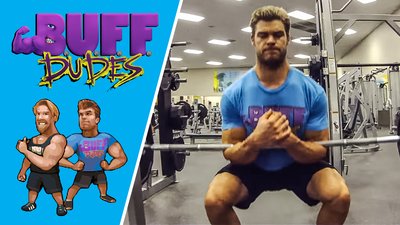Muscle cars, Steve McQueen, and Zercher squats. What do these three things have in common? They're old school cool—gone, but not forgotten. Well, we're bringing back Zercher squats and seven other old-school exercises, and we're doing it in a big way.
Bust out that Black Sabbath eight track, throw on your Rocky Balboa sweat pants, and let's make old school cool again.
Zercher Squats
If you've never tried a Zercher squat before, you're in for a real treat. Yes, at first this exercise can be an uncomfortable position to squat in. But with practice and the willpower to push through the pain, you'll reap some serious benefits. Here are just a few:
- It increases upper-back activation, including your trapezius, rhomboids, and rear deltoids.
- It works your core overtime to stabilize your spine.
- It's an easier way to get in the full-squat or "ass to grass" position.
- It forces both your quads and glutes to do more work than other squat variations.
- It builds some serious biceps. Since you're holding the barbell in the crook of your arms, your biceps are forced into an isometric contraction, which will increase their strength and size.
Zercher Squat Technique
Step 1: Walk up to a squat rack with the barbell placed about waist high. With your elbows at your sides, place the barbell in the crook of your arms. Flex your elbow joints, clasp your hands together, and squeeze that barbell tight against you like it's your very own "Precious... My Precious."
Step 2: Unrack the barbell and walk back half a step. Keep your stance wide, with your feet pointing outward no more than 12 degrees.
Step 3: Keep your torso upright as you squat down into the bottom position. Your elbows should fall against your inner-thigh area as your knees track in line with your toes. Push through your midfoot, with a neutral chin, until you reach the top position to end the movement.
Bradford/Rocky Press
Knowledge drop: We have Olympic weightlifter Jim Bradford to thank for developing this fantastic exercise. You'll notice immediately that this move works on "time under tension" (TUT), and provides multiple ways to work your shoulders. Here's how and why we like to use it.
- It can double as an excellent mobility drill.
- It's a great shoulder warm-up for heavy pressing.
- It activates all three heads of the deltoids along with the trapezius, rhomboids, and rotator cuffs.
With all that going for it, it's no wonder we chose the Bradford press as one of the "Best Shoulder Exercises You're Not Doing".
Bradford Press Technique
Step 1: Walk up to the squat rack with the barbell placed just under your clavicle, or clean the bar if you feel confident enough. Use a grip wider than a typical overhead press (outside shoulder width) to allow for better movement and mobility throughout the exercise.
Step 2: Keeping your forearms vertical, push up the barbell until it reaches just above your head. As the barbell passes the top of your head, start to retract (adduct) the scapula and flare your elbows wide to bring the barbell behind your skull. Slowly drop your elbows to lower the barbell. Lower it only as far as the base of your skull before pressing and pronating (abducting) the scapula to bring the bar to the front and back to the beginning position.
Note: Don't go heavy with this exercise. Keep it light and be safe.
Otis-Up
The Otis-Up is an abdominal destroyer that will add some upper-body work to your routine. Maybe because it's got a foot in both camps, people are quick to dismiss it in favor of something that focuses squarely on one group or the other. But to us, it's another oldy but goody. Here's why.
- It uses spinal flexion through the first half of the movement and spinal stabilization once you reach the top position.
- It hits the abdominal muscles, obliques, and lower back (stabilizing at the top).
- Because of the pressing motion, it works on the pectoralis major (sternal and clavicular), deltoids, lats, and more.
Otis-Up Technique
Step 1: Lay in a supine position (face up) on the floor with your knees bent and feet anchored.
Step 2: Grab a weight—either a plate, dumbbell, barbell, or medicine ball. Start with the weight at your sternum and the back of your arms on the floor.
Step 3: As you crunch in your abs, flex your spine while pushing your hips and lower back into the floor. At the same time, press up the weight. Rolling your spine off the floor, keep your abs tight and let your shoulder joint extend until you reach the top position.
Step 4: When you're in the top position, your upper trunk should be vertical and your arms at full extension in line with your torso. Reverse the motion to bring yourself back to the starting position.
Drag Curl
The name itself sounds pretty cool and actually explains the movement very well. But are drag curls worth doing? Well, if you want to see growth in a particular muscle group—namely, the biceps—isolate it from other muscles that might help move the load. There are certain ways to really isolate a movement or muscle, and this old-schooler is one of 'em.
- It takes out shoulder flexion and shoulder activation.
- It eliminates momentum.
- It forces you to utilize both a fuller range of motion and maintain stricter form.
Drag Curl Technique
Step 1: Grab a barbell at shoulder width in the standing position.
Step 2: Slowly contract your biceps by flexing your elbow joints. Let your elbows move back as you curl up, using your body as a guideline for the bar to travel. The bar will "drag" up your body as you curl. Once you reach the top position, squeeze, and let down the bar slowly.
Scott Press
Good ol' Larry Scott. He was the first Mr. Olympia and one of the greatest, and he used this press developed by Vince Gironda to bring up his lagging shoulders. What sets this exercise apart from any other shoulder press is the fact that it takes the triceps out of the equation. Which makes sense, because if you know about Larry, you know he didn't exactly need bigger arms.
But, you might be asking, "How the hell do you take triceps out of a pressing exercise?" Well, you do it by focusing on the scapula retraction and elevation, not elbow extension. Here's what else this move has going for it.
- The lateral and posterior deltoids are worked, along with the trapezius.
- The lighter weight and short range of motion make relatively easy to master this move.
Scott Press Technique
Step 1: Start in either a standing or seated position. Grab a pair of dumbbells and hold them out shoulder width in front of you with your arms at a 90-degree angle and your palms facing each other.
Step 2: Start retracting your scapula and flaring your elbows out to the side of your torso, while at the same time elevating your scapula until you reach peak contraction.
Note: This movement should feel fluid and natural, so start with a very light weight to get the hang of it.
Stomach Vacuum
The vacuum is a technique many old-school bodybuilders used, supposedly to help keep their waists small. Because the vacuum exercise focuses on strengthening the transverse abdominis muscle (TVA), this may actually be true. The TVA helps stabilize the spine and holds the abdomen in tight. The vacuum is nicknamed "the corset muscle" because it keeps those waists narrow. Old dudes knew what was up.
Stomach Vacuum Technique
Step 1: You can perform this movement seated, standing, or on all fours facing downward. They're all great.
Step 2: Exhale all the air out of your lungs. Expand your chest and visualize touching your belly button to your spine. Hold for 10 seconds, or make it fun by seeing how long you can last (without passing out, that is).
Floor Press
This one is definitely an old schooler. In fact, the floor press was the initial exercise that eventually evolved into the very well-known bench press. There are a couple key differences between the floor press and the bench press.
One difference (obviously) is that you do floor presses on the floor, which creates a shorter range of motion (ROM). The shorter ROM works the upper half of the push while simultaneously taking out the leg drive. No leg drive means stricter upper-body push through the chest, triceps, and shoulders. It has other benefits, too.
- More triceps involvement can help you increase your triceps size and strength.
- The floor press will also improve your bench-press lockout.
- It minimizes stress on your shoulders.
This move was a no-brainer to include in our "Best Chest Exercises You're Not Doing."
Floor Press Technique
Step 1: Lie on the floor, feet extended flat, with the barbell racked on a squat cage just above you at arm's length.
Step 2: Unrack the bar and slowly lower until the backs of your upper arms rest on the floor. Then explosively press up to the top position.
Dumbbell Pull-Over
This exercise has a long history, full of ups and downs. Back in its heyday, pull-overs got props in one way or another from every well-known bodybuilder from the golden era. It was credited with expanding bodybuilders' ribcages to create those famous herculean chests, and also for generating massive upper-body skin-tearing pumps in both the chest and lats.
But the excitement eventually died away for this poor exercise, and today, the pull-over largely just a memory. Let's not let it fade into obscurity! Here's some of what makes this classic move great:
- It's a great way to work on your upper-body flexibility, specifically the shoulders and thoracic spine.
- It'll help you develop your pectoralis major (sternal head), posterior deltoids, latissimus dorsi, and triceps. It also hits plenty of small but important muscles like the teres major.
- It'll give you a damned good upper-body pump.
Dumbbell Pull-Over Technique
Step 1: Lie crossways on a bench. Take a dumbbell with a diamond grip, holding the inner far side of the weight at arms' length directly above your chest.
Step 2: Take a deep breath as you flex your shoulders and allow the weight to move back and behind your head, bending your elbows as much as necessary. Stop when you feel the stretch in your lats, chest, and/or triceps.
Step 3: Once you reach the full stretch position, exhale as you use shoulder extension to pull the weight back over to the starting position.
Note: Not every dude or gal has the mobility and flexibility to make this move work right out of the gate. Take it light and take it slow to feel out your range of motion.

